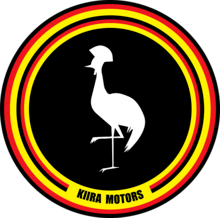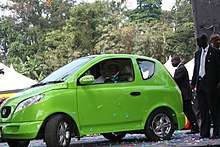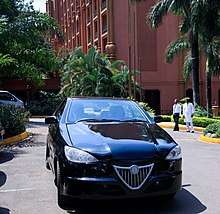Kiira Motors Corporation
 | |
| Public | |
| Industry | Automotive |
| Founded | 2014 |
| Headquarters | Ntinda, Kampala, Uganda |
Key people |
|
| Products | Automobiles |
| Website |
kiiramotors |
Kiira Motors Corporation or KMC is an automobile manufacturing company in Uganda owned by the Government of Uganda and Makerere University.[1]
KMC developed Africa's first electric vehicle in 2011, Africa's first hybrid vehicle[2] in 2014 and Africa's first solar electric bus[3] in 2016.[4]
KMC envisions to start production of vehicles in 2018 with Pick-Ups, Buses, Light and Medium Duty Trucks.[5] The company announced that it was taking orders for buses in October 2017.[6]
History
The KMC journey dates back to 2007; evolving from an extra-curricular activity under the auspices of then Makerere University Faculty of Technology, to a university curricular activity and later a mainstream national initiative for automotive manufacturing. In 2007, a global consortium of over 31 universities and colleges across the world took part in a Vehicle Design Summit (VDS) to design and bring to market a 5-Seater plug-in hybrid electric vehicle, the Vision 200, targeting the Indian market.[7]

Under the United States-based Massachusetts Institute of Technology led three-year project, Uganda's Makerere University was the only participant from Africa. The team from the Faculty of Technology now College of Engineering, Design, Art and Technology was responsible for design and integration of the Low Power Electronics and Data Networking Systems.[8] Given the experience in building the Vision 200, other global experiences through collaborations, and best practices benchmarking, the Makerere team resolved to embark on a project aimed at designing and building a vehicle in Uganda.[9]
The Center for Research in Transport Technologies (CRTT) was then conceived under Makerere University in December 2008 and approved as part of the University Structures effective 1 January 2011. The strategic goal of CRTT was to advance research and innovation in transportation technologies on land, air and sea with specific emphasis on green mobility solutions for Africa. The Kiira EV Project was the first project implemented under CRTT.[10] The Kiira EV, Africa's first electric vehicle, was completed by the team and launched by H.E Yoweri Museveni, the President of the Republic of Uganda, on 24 November 2011.[11]

The successful execution of the Kiira EV Project led to the establishment of the Kiira Motors Project as a government initiative for Automotive Industry Development aimed at Establishing a Vehicle Plant in Uganda. The Kiira Motors Project started the Kiira Vehicle Technology Innovation Program through which the Kiira EV SMACK, the first Electric Hybrid Vehicle designed and built in Africa, was developed and unveiled at a very high-profile event at the Kenyatta International Convention Centre in Nairobi, Kenya in November 2014.[12][13]

The team then designed and built the Kayoola Solar Bus, the first Electric Solar Bus designed and built in Africa. The Kayoola Solar Bus was launched by H.E Yoweri Museveni on 16 February 2016 at the Kampala Serena Hotel.[3]
Kiira Motors conducted a Pre-Investment Analysis (The KMC Business Case) to affirm the viability of vision Vehicles Made in Uganda. This informed the development of the Kiira Motors Corporation Business Strategy and subsequently Business Plan. The KMC Pre-Investment Analysis (Business Case) was launched by the Uganda Prime Minister Ruhakana Rugunda on 7 December 2015 at the President's Office Conference Hall.[14][15]
The government of Uganda, acting through the Uganda Investment Authority (UIA), allocated 100 acres for the KMC factory, located at the Jinja Industrial and Business Park.[16]
Commercial Production
Cabinet of Uganda sitting on Monday 9th April 2018 at Statehouse Entebbe approved the roadmap for Commercialization of the Kiira Electric Vehicle Project.[17] This is to be undertaken in a phased manner with the market-entry point being assembly of vehicles (including electric vehicles) in partnership with reputable vehicle manufacturers.[18] Cabinet approved a Seed Fund of US$ 40 Million (USh 143.7 Billion) over a period of four years starting in the Financial Year 2018/19 with an allocation of USh 24 Billion under the Ministry of Science, Technology and Innovation.[19] Cabinet authorised the Minister of Science, Technology and Innovation to put in place the necessary Institutional Framework for the Commercialization of the Kiira Electric Vehicle Project. The assembly plant is expected to have an installed capacity of 5,000 vehicles annually.[20][21]
Awards
KMC was recognized for the initiatives in Green Mobility by Frost & Sullivan with the prestigious 2016 Frost & Sullivan Visionary Innovation Leadership Award in Sustainable Mobility.[22]
References
- ↑ Kiira Motors (10 April 2018). "Kiira Motors Corporation: About Us". Kampala: Kiiramotors.com. Retrieved 10 April 2018.
- ↑ Nasasira, Roland (4 February 2016). "KIIRA EV SMACK: A car made in Uganda". Daily Monitor. Retrieved 17 October 2017.
- 1 2 Patel, Heenali (15 February 2016). "Uganda unveils Africa's first solar-powered bus - CNN". Cable News Network. Retrieved 10 April 2018.
- ↑ BBC (1 February 2016). "Africa's 'first solar bus' unveiled". London: British Broadcasting Corporation (BBC). Retrieved 10 April 2018.
- ↑ Emmanuel Ainebyoona (8 December 2015). "Uganda to start assembling vehicles in 2018". Daily Monitor. Kampala. Retrieved 10 April 2018.
- ↑ Paul Sserwanga (10 October 2017). "Ugandans Eager to Buy Kiira Motors Vehicles as Kayoola Solar Bus Shines at UMA". Kampala: Theugandatoday.com. Retrieved 10 April 2018.
- ↑ Makerere University (10 April 2018). "Vehicle Design Project: (2006–2010)" (PDF). Kampala: Makerere University. Retrieved 10 April 2018.
- ↑ EVWorld.com (4 September 2008). "Ugandan Students Participate in International Plug-in Hybrid Project". EVWorld.com. Retrieved 10 April 2018.
- ↑ B Wilkins (5 March 2016). "Solar-powered buses redefining public transportation in Uganda". Launchforth.io. Retrieved 10 April 2018.
- ↑ Makerere University (8 June 2017). "Center for Research in Transportation Technologies: The College of Engineering, Design, Art and Technology, Makerere University". Makerere University. Retrieved 10 April 2018.
- ↑ Makerere University (25 November 2011). "President Museveni Launches Kiira EV, Pledges More Support to Makerere". Kampala: Makerere University. Retrieved 10 April 2018.
- ↑ Mulupi, Dinfin (25 November 2014). "Introducing the 'Made in Uganda' electric car". How We Made It In Africa. Retrieved 10 April 2018.
- ↑ Anguyo, Innocent (13 November 2014). "Uganda's hybrid car launched in Kenya". New Vision. Kampala. Retrieved 10 April 2018.
- ↑ PC Tech Magazinne (8 December 2015). "Made in Uganda: Kiira Motors says vehicle assembly will start in 2018". PC Tech Magazine. Retrieved 10 April 2018.
- ↑ Lyatuu, Justus (9 December 2015). "Kiira Motors to employ 10,000 people". The Observer (Uganda). Kampala. Retrieved 10 April 2018.
- ↑ Okello, Picho (8 February 2016). "UDC Projects: Kiira Motors Corporation". Kampala. Retrieved 10 April 2018.
- ↑ "Uganda Backs Electric Vehicle Project It Says Can Lead Continent". Bloomberg.com. 2018-04-10. Retrieved 2018-05-01.
- ↑ "Cabinet nods to Kiira Motors commercialisation, slams brakes on URA bank accounts bid | 256 Business News". 256businessnews.com. Retrieved 2018-05-01.
- ↑ "Govt Allocates Shs 24Bn for Kiira Motors' Car Assembly Plant – Online news from Uganda and the East African region – SoftPower News". www.softpower.ug. Retrieved 2018-05-01.
- ↑ "Uganda to manufacture cars starting this year as cabinet approves cash". Nile Post. 2018-04-10. Retrieved 2018-05-01.
- ↑ Xinhua (11 April 2018). "Uganda to start commercial production of motor vehicles". The EastAfrican Quoting Xinhua. Nairobi. Retrieved 13 April 2018.
- ↑ Frost & Sullivan (15 August 2016). "Frost & Sullivan Recognises the Drive and Vision of Kiira Motors Corporation in Redefining Mobility in Uganda". Frost & Sullivan. Retrieved 10 April 2018.
